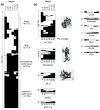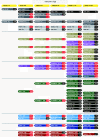The developmental expression dynamics of Drosophila melanogaster transcription factors
- PMID: 20384991
- PMCID: PMC2884543
- DOI: 10.1186/gb-2010-11-4-r40
The developmental expression dynamics of Drosophila melanogaster transcription factors
Abstract
Background: Site-specific transcription factors (TFs) are coordinators of developmental and physiological gene expression programs. Their binding to cis-regulatory modules of target genes mediates the precise cell- and context-specific activation and repression of genes. The expression of TFs should therefore reflect the core expression program of each cell.
Results: We studied the expression dynamics of about 750 TFs using the available genomics resources in Drosophila melanogaster. We find that 95% of these TFs are expressed at some point during embryonic development, with a peak roughly between 10 and 12 hours after egg laying, the core stages of organogenesis. We address the differential utilization of DNA-binding domains in different developmental programs systematically in a spatio-temporal context, and show that the zinc finger class of TFs is predominantly early expressed, while Homeobox TFs exhibit later expression in embryogenesis.
Conclusions: Previous work, dissecting cis-regulatory modules during Drosophila development, suggests that TFs are deployed in groups acting in a cooperative manner. In contrast, we find that there is rapid exchange of co-expressed partners amongst the fly TFs, at rates similar to the genome-wide dynamics of co-expression clusters. This suggests there may also be a high level of combinatorial complexity of TFs at cis-regulatory modules.
Figures





Comment in
-
Mapping the complexity of transcription control in higher eukaryotes.Genome Biol. 2010;11(4):115. doi: 10.1186/gb-2010-11-4-115. Epub 2010 Apr 30. Genome Biol. 2010. PMID: 20441601 Free PMC article.
References
-
- Davidson E. The Regulatory Genome: Gene Regulatory Networks in Development and Evolution. Academic Press; 2006.
Publication types
MeSH terms
Substances
Grants and funding
LinkOut - more resources
Full Text Sources
Molecular Biology Databases
Research Materials

